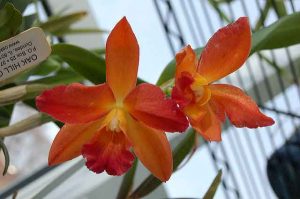
Case of fate brought to the notary's office. Beautiful flowers everywhere, especially the orchid.
Not an office, but a real flower showcase. But the conditions are not the same as in the greenhouse, so the flower suffered the fate of many orchids.
A professional look immediately determined the presence of a mushroom mosquito. What to do if midges are found in orchids, and this is how a mosquito looks like, read the article.
The content of the article:
- 1 What midges are found in orchids?
- 2 Insects that plant in orchids
- 3 Orchid midge control measures
- 4 Midges in orchids wound up. How to get rid of an insect
- 5 Orchid Pests
- 6 Black midges fly near a flower, sciarida
- 7 How to get rid of insects?
- 8 How to prevent pests?
- 9 Mushroom mosquitoes
- 10 How to get rid of midges in orchids
What midges are found in orchids?
Cats in orchids. What to do?
If you notice that midges fly around the pot with an orchid, then you may have questions:
- What midges are found in orchids?
- Are midges in orchids dangerous?
- What needs to be done, and how to get rid of midges in orchids?
- Today's article is devoted to answers to these questions.
The clowns that wind up in orchids can be "harmless" mushroom mosquitoes, or they can be "harmful" thrips. In order to choose the right remedy, it is necessary to identify a flying insect.
First, analyze your watering regime and make sure that you do not fill the orchid and leave two or three dry days between waterings. In this case, dry days are considered not those days when the soil dries on the surface of the pot, but those days when the soil dries completely throughout the entire depth of the pot.
For more information on how to determine if the soil has dried in a pot with an orchid, read the article "How to Water an Orchid Frequently." Next, evaluate if there is damage to the leaves of the orchid: multiple dark dots or a silver film.
Mushroom mosquito in orchid
If you water the orchid often and do not leave two or three dry days between watering, and there are no characteristic damage on the leaves (multiple dark spots or a silver film), then in your case, most likely, a mushroom mosquito has gotten into the orchid.
To finally verify this, evaluate the habitats and appearance of midges.
Where live? Mushroom mosquitoes live in the ground. If we talk about orchids, then, as a rule, mushroom mosquitoes settle in those pots in which the soil consists not only of bark, in which moss or peat is added.
Appearance? Adults are similar to small black mosquitoes, in fact they are most often represented when they talk about "midges".
Are they dangerous? Adult mushroom mosquitoes do no harm. Larvae can cause harm, which in large quantities can damage the roots.
How to treat? The main method of protection is drying: in dry soil the larvae do not hatch, and adult individuals live for two weeks. Start by cutting down on watering your orchids.In addition, you can buy yellow tape in a flower shop to collect adults.
Or put a yellow saucer with water - mosquitoes fly to yellow. In extreme cases, you can replace the soil by washing the roots of the orchid from mosquito larvae. And in the future, follow the general rules for watering an orchid.
Thrips in orchids
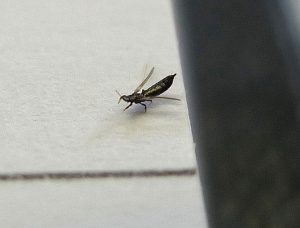
Where live? Thrips, unlike mosquitoes that live in the ground, live on leaves and actively feed on orchid leaves.
Appearance? They have an elongated shape, a striped abdomen and two wings.
Thrips, rather, do not even fly, but quickly run and hide in the bark. Multiple lesions appear on the leaves - the places of the bites,
Are they dangerous? Thrips, unlike mushroom mosquitoes, do significant harm to the orchid. Insects pierce plant cells and completely suck out the juice from them. Fungi can occur in the places of the bites.
The orchid leaf itself receives not only and not so much a decorative defect, but dies, devoid of cellular juice. Therefore, if thrips are found on an orchid, you should not delay with their destruction.
How to treat? For treatment, it is necessary to rinse the orchid in the shower (during the next watering), which will allow to wash off some of the individuals, and treat the orchid with a phytoderm (or other drug for thrips) according to the instructions at least 3 times with a break of 10 days.
Insects that plant in orchids
Currently, growing orchids as indoor plants is gaining popularity. But gardeners often encounter a problem when small midges in orchids start up, which can damage plants.
Where do midges appear in orchids?
Often, pest larvae are introduced along with the soil. After flowers are planted in it, midges appear that rapidly multiply. If insects are wound up in one of the pots with houseplants, they also inhabit neighboring ones, if there are suitable conditions.
One of the main conditions is sufficient soil moisture. Excessive watering can be one of the reasons for the emergence and rapid reproduction of midges in flowers. Before taking any control measures, it is necessary to find out what midges wound up in home orchids.
- If you notice damage, but did not find any pests, take a moment to use chemicals - this may be due to sunburn or other troubles. Most often, in the soil where orchids grow, scyarids settle - small insects 3-5 mm long, black in color, popularly called flower midges.
- In fact, these are mushroom or fruit mosquitoes, similar to small flies. These insects lay eggs in the ground, where larvae similar to worms develop, 6-7 mm long, white. Scyarides themselves do not harm plants, but their larvae damage seedlings, thin roots of weakened plants and seedlings.
- These lesions can become foci of rot and lesions of fungal diseases. Therefore, small black "midges" settled in orchids can cause significant harm to plants. Florists are often mistaken for white small midges of tiny butterflies - whiteflies.
- These tiny insects fly quickly and hide well. It is not difficult to detect these insects, you just have to touch the leaves or the ground, and they immediately take off. Butterflies are usually not interested in plants with dense leathery leaves, but settle on thin-leaved orchids with delicate skin.
Whiteflies and their larvae feed on plant sap, sucking them from the leaves.As a result, the plant withers, the affected leaves curl up and turn yellow. The eggs and larvae of this pest are yellowish. They can be found on orchids - on the surface of leaves, under the bark and leaves.
Another type of insect that infects orchids and looks like midges is thrips. Insects are very small, only 2–2.5 mm long. They can cause serious damage to any type of orchid. Thrips are like small dark brown or black “sticks”, equipped with two pairs of wings, which are folded on their backs.
They run fast and instantly hide in the ground. Unlike sciarids, thrips, having flown onto a plant, try to hide in the substrate as quickly as possible. These pests are nocturnal, and it is extremely rare to see them during the day.
Thrips eggs are laid in leaf tissue. The larvae that emerged from them (tiny yellow or green worms), which are almost impossible to see with the naked eye, live inside the leaves, feeding on their tissues.
As a result, the leaves are covered with many holes and dark spots, wither and die. These "midges", settling on orchids, affect both leaves and flowers, and also "bite" the roots. Flowers have lesions similar to leaves; constrictions appear on the roots.
Sometimes in the pots where orchids grow, fruit flies (Drosophila) settle. This small insect is about 3 mm long. They feed on fermented vegetables and fruits, as well as food residues of plant origin.
In the substrate, these midges settle if the plants are watered with tea leaves or sprinkled with tea leaves from the teapot as fertilizers, which is undesirable. Sometimes they are attracted to half-matured moss or peat.
But Drosophila can choose a breeding ground as a breeding pot if the soil in it is constantly excessively watered. For plants, the insects themselves and their larvae are completely harmless, but gardeners should beware of the fact of their settlement in the ground - there is definitely an excessive watering, which may not be harmless to the root system.
Orchid midge control measures
Watch carefully for orchid watering - excessive moisture in the soil can cause midges.
Orchid midge control measures
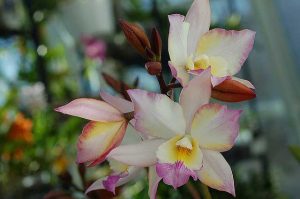
First of all, it is necessary to find out which insects settled in the flowers. Depending on the type of insects, control measures are selected.
If Drosophila settled in the pots, then it is quite possible to do without the use of pesticides.
It is necessary to remove the mulching layer from tea or moss from the pots and reduce watering so that the substrate has time to dry out.
- In addition, it must be ensured that there are no rotten vegetables, fruits and food residues in the room. If Drosophila is completely deprived of food, then nothing more needs to be done: after a short period of time, they will disappear themselves.
- To speed up the process, you can additionally use sticky traps for flies. It is somewhat more difficult to deal with scyarides, but it is quite real. In order not to introduce insects with the soil, it is advisable to use special sterilized soil mixtures.
- If the substrate is prepared on its own, then it should be abundantly poured with water and allowed to drain, after which it should be frozen for several days. Often, fish bones, coffee grounds, sleeping tea leaves, etc. are poured into pots with orchids as fertilizers.
- This should not be done, because, decomposing, such fertilizers can be an excellent environment for the larvae of the mushroom mosquito.Against the flying "fly" - sciarides - they use drugs for the destruction of flying insects: Raptor, Raid, Neodichlorvos and others.
They need to spray shelves, window sills, window frames. To get rid of the larvae that are in the substrate, they use soil insecticides, such as Thunder-2, Bazudin, etc. As scaring agents, they place citrus peels, garlic cloves, dill branches or lavender leaves in pots.
You can get rid of whitefly butterflies by spraying the affected plants with a five-day interval with insecticides (Fury, Aktara, Sherpa, Bazudin, etc.). Good spraying of plants and substrate "Actellicom".
As an additional tool, orchid leaves are washed with a solution of laundry soap (1: 6 ratio). It is useful to spill the substrate once a month under running water. To combat thrips, plants and soil are sprayed with “Fitoverm” or “Actellik” two, or better, three times, with an interval of 10 days.
For preventive purposes, the leaves are wiped or washed every five days. The soil is shed under running water once a month.
Midges in orchids wound up. How to get rid of an insect
Small midges in orchids can lead to the death of the plant. To prevent this, you need to get rid of them. We will fight by various methods and means. Orchid is an unusually delicate and beautiful flower that can be found in almost every home.
Midges appear due to contaminated soil. The substrate, which is acquired for the plant, can be infected by larvae, which, after planting, begin to multiply rapidly. The cause of the appearance of insects can also be increased soil moisture.
Fighting midges
Identify the species of midges that attacked the beautiful plant. Then you need to pick up control measures.
- Drosophila. To combat this type of insect, it is not recommended to use pesticides. It is enough to remove moss from the pot and reduce watering. This method will make it possible to dry the substrate and thereby the insects will disappear.
- Sciarida. To deal with these midges is a little more difficult. To prevent insects from entering the soil, use special sterilized soil mixtures. Such drugs are used to eliminate the flying fly: "Raptor", "Raid", "Neodichlorvos". To get rid of the larvae that are in the substrate, apply soil insecticides: “Thunder-2”, “Bazudin”.
- Whitefly butterfly. Treat the plant with insecticides: “Fury”, “Aktara”, “Sherpa”, “Bazudin”, “Actellik”.
To avoid infection, wash orchid leaves with soapy water. It is also useful to spill the substrate once a month under running water.
Orchid Pests
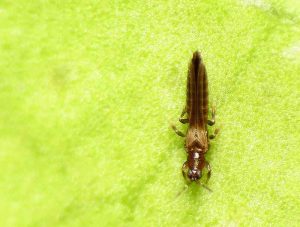
Fortunately, in our country most of these pests do not live. In house culture, orchids suffer from several types of pests that are widely specialized and besides orchids damage a number of ornamental and agricultural plants.
When growing seedlings, in addition to snails and slugs, woodlice are extremely dangerous, biting young roots and the bases of the bulbs on which the kidneys are located.Adult plants of wood lice are not so threatened, but with a very high number they cause noticeable damage to their roots.
In addition, on orchids, there are a number of sucking pests - worms, scutes and ticks, which, eating plant sap, greatly weaken it and, importantly, significantly worsen the appearance of the orchid.
All these pests are brought into rooms with newly acquired plants, so each new specimen is carefully inspected and subjected to preventive treatment for insurance.
In no case do not spray the leaves and stems of plants with aerosol, as this almost certainly causes severe burns and the complete death of orchids. After treatment, the plant is washed with warm water and placed in its intended place.
In order to eliminate a disease or pest, it is necessary to learn how to determine which factor or organism actually caused this or that damage.
Black midges fly near a flower, sciarida
Mushroom mosquitoes or sciarids fly around the pot - small, black-colored insects. First of all, reduce the watering of plants, so that before the next watering the top layer of the earth has time to dry. Scyaride is attracted to the soil, where the process of decay or decomposition of organic fertilizers is actively underway.
Therefore, first of all, mosquitoes lay eggs in pots with plants watered with tinctures of mullein, bird droppings. It is also noted that mushroom mosquitoes tend to appear when using dirty water for irrigation: from an aquarium, tea leaves, water after washing meat products.
Initially, insects settle in pots with a waterlogged substrate. With long and intensive reproduction, insects no longer pay attention to dry soil. If you lightly tap the pot with the plant or shake the pot, and a flock of flies soars above the ground, this is a sign that there is an egg laying. In such a pot, it is better to immediately replace the entire soil.
In the upper soil layer, you can see whitish, translucent larvae with a black head, up to 5 mm long, and in the thick of the roots there are whitish, granular formations that crumble if you squeeze them harder with your fingers - these are pupae or pup pelts after the departure of adults. If there are not many pests, then they take control measures without replanting the flower with flying individuals and larvae.
They struggle with flying insects by the same means that they use to control house flies: spraying plants with dichlorvos aerosols, fumigating a room (room) with raptor or fumitox flakes, hang adhesive adhesive tapes for flies next to the plant, and restrict mosquitoes from entering the apartment using a mosquito net on windows and vents.
After the introduction of the insecticide, the plants are not watered for 3-5 days. If watering the soil with insecticide, the larvae crawl to the surface. Or they bring soil insecticides into the ground in granules thunder 2, bazudin, but their effect is slower.The drug is scattered in a thin layer on the ground, then mixed with the upper layer of soil.
How to get rid of insects?
If you saw any midges in orchids, this is an occasion to think. Such pests can cause slow flower growth and even provoke its death.
Where do midges appear in orchids?
Therefore, it is imperative to take preventive measures to protect the plant from all insects, and after their appearance, orchids must be treated with special compounds.
What midges can be found on orchids?
Moshkara in orchids
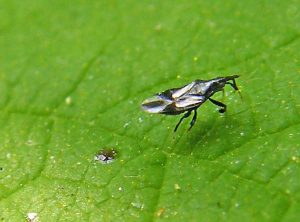
- Sciarides. Small black insects that are most often found in the ground. Their size is 3-5 mm. Scyarid is also called flower midges, mushroom or fruit mosquitoes. The danger of these insects is that they lay eggs in the soil, from which white worms 6-7 mm long are formed. They damage the roots of the plant, which provokes the development of putrefactive processes. As a result, the flower may die;
- Whiteflies. These are small white midges that feed on juice from the soft leaves of plants. From this, the flower gradually dries and as a result dies. Whitefly larvae, which can be found on leaves, stems or in the soil, are also dangerous. They can be recognized by their yellowish color;
- Thrips. Their body is elongated, on the abdomen there are several stripes and a pair of wings. Thrips damage orchid leaves. Small holes form on their surface. The leaves themselves become white or silver, and after a while they darken. These insects can hide in the soil, but most often they can be found on the top of the orchid. Thrips eventually leads to the death of the plant;
- Drosophila (fruit midges). These are small flies that can be found on a pot or near a flower. They are harmless to the plant. The appearance of Drosophila signals an improper care for the orchid.
How to prevent pests?
So that orchids do not start midges, you must adhere to these recommendations:
- clean the moss flower substrate. It is an attractive medium for different types of insects;
- for planting a flower, use a special substrate. Its composition includes substances that are necessary for normal plant growth;
- organize optimal watering. In summer, it should be carried out 2 times a week, and at other times of the year - 1 time;
- do not fertilize the soil with tea brewing, infusion from egg shells or other non-traditional fertilizers;
- keep the plant away from food waste, fruits and vegetables;
put mosquito nets on the windows. This will protect the flower from insects that can fly in from the street.
Method - how to get rid of insects
If there are midges on your flowers, you need to take some measures to remove these pests. This must be done until you completely get rid of insects. The following measures are recommended:
- You can put tape near the flower. Gnats will gather on its surface. To attract insects, put a simple bait - a saucer with yellow water. Replace the tape periodically to permanently remove all pests;
- try transplanting an orchid, completely replacing the entire substrate. It is recommended to rinse the roots under running water. Also carefully inspect the entire plant and remove the rotten parts;
- use a weak solution of potassium permanganate. Use this product to water as needed. Conduct treatment in this way for 1-2 months;
- To remove pests, rinse the leaves of the plant in the shower. A stream of water will remove insects. This must be done several times with a frequency of 3-4 days;
- use regular mustard powder. Sprinkle the surface of the soil with a dry mixture.Repeat the procedure several times every 5-6 days until these pests completely disappear;
- apply river sand. Before the procedure, bake it in the oven for several minutes. Then sprinkle their soil surface. If the pests do not die after a few days, repeat the procedure;
- use matches. For one pot you need to take 5-6 pieces. Insert them head into the ground and irrigate as necessary. When the sulfur has dissolved, replace the matches.
Chemicals
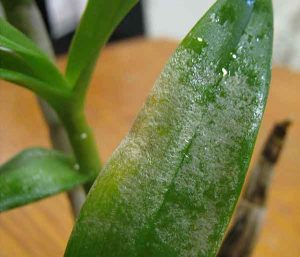
They contain chemical compounds that are harmful to these pests.
In the fight against sciaridae, it is best to use such drugs as Raptor, Raid, Neodichlorvos.
The first of the means may be in the form of:
- aerosol. It must be periodically applied to the plant until you can get rid of all insects;
- a special device with liquid, which only needs to be connected to the network. Instead of mortar, plates can be used;
- aquafumigator. The active substance is distributed using steam, which is formed after a chemical reaction with water.
Raid and Neodichlorvos is applied to leaves and flowers using an aerosol. Against larvae, it is best to use Thunder-2 or Bazudin. They must be dissolved in water and applied to the soil surface according to the instructions.
Orchid is one of the most amazing creations of Mother Nature. On the one hand, the plant has a terrifying root system, as if it came from scary dreams or science fiction films. On the other hand, its bloom causes only delight, the beauty and grace of flowers, the appearance of new and new buds, it seems that the miracle will continue indefinitely.
Sometimes housewives begin to notice that a company of small midges appears around the orchid, which together take off above the flower when watering and immediately hide. What are these insects, what harm can they bring and how to deal with them?
You need to figure out what kind of neighbors appeared at your favorite flower. The most frequent guests of orchids are the so-called mushroom mosquitoes and thrips. The former are quite harmless, although their appearance is both annoying and scary. The second - a real disaster for the plant, as soon as the first uninvited guests appeared, you must immediately begin to fight them using all available methods.
Mushroom mosquitoes
In order to make sure that the company of the orchid is a mushroom mosquito, you need to evaluate the appearance of the plant and the irrigation system organized in the house. This guest appears when the owners violate the watering regime, that is, they do not leave 2-3 days to completely dry the soil, but keep the plant constantly in a moist state. In this case, the appearance of the plant does not change:
- the leaves of the flower remain dry, shiny;
- without visible damage in the form of multiple dark dots;
- There is no silver film on the leaves.
Such guests live in the ground, in which there is not only bark, but peat or moss. If you look closely at the appearing “midges”, you can see that outwardly adult individuals resemble tiny black mosquitoes of a tiny size, hence their biological name.
The danger is not the mushroom mosquitoes themselves, but their larvae, the habitat of which becomes soil. The way to deal with them is quite simple - drying the soil. Therefore, you can carry out the following actions:
- Reduce the amount of watering the plant. Excessive humidity only harms.
- Buy yellow adhesive tape, spread around the plant to collect adults who adore yellow. For the same purpose, put a yellow saucer filled with water next to it.
- Replace soil. In this case, it is imperative to rinse the roots of the plant so that no mosquito larvae remain.
- Mosquitoes are not the worst “lodgers” that can live in an orchid. Much more sad consequences await those plants in which thrips are wound.
Scary and terrible
Thrips are insects, they have an elongated body shape, wings pressed against a striped body. Their habitat is not the soil, but the plant itself, the leaves of which are their favorite food. Thrips move very quickly, when a person appears, they immediately hide in the cortex.
It is necessary to use all means - both physical, and chemical, and biological. Firstly, instead of the next watering, the plant needs to be washed well in the shower - so part of the insects will be washed off with water.
Secondly, you need to use any chemicals that help fight thrips, for example, Fitoverm or Actellik. Moreover, it is necessary to act strictly according to the instructions, observing the dosage and the recommended treatment time.
How to get rid of midges in orchids
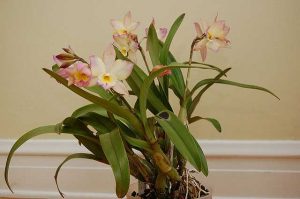
In a pot, on a stalk or on leaves you can see unwanted guests - various insects that oppress your orchid and prevent it from fully growing and developing.
Of course, the question arises before us: "How to get rid of midges in orchids?" In order to understand how to deal with pests, you first need to determine who exactly you got.
Types of midges in orchids
The insects that live with your plant can be varied: from harmless mushroom mosquitoes to harmful thrips. To make the treatment as effective as possible, find out who occupied your orchid.
Mushroom mosquito in orchid
This type of midge starts in the plant, if you do not leave time between watering, at least a couple of days. There is no damage to the leaves, no multiple dark dots or silver film.
Mushroom mosquitoes live in the ground, mainly one that consists of bark with peat or moss. In pure bark, they settle only if it has completely decomposed. In appearance, these midges resemble just the same little black mosquitoes. Most often, they are observed in a pot with an orchid.
Adult individuals do not harm the plant, but large numbers of larvae can damage the roots. The treatment is as follows: first dry the soil. Reduce the amount of watering, as in dry soil the larvae will not hatch, and adults will live on the strength of two weeks.
To speed up the removal of pests, put a yellow saucer next to water or buy a special yellow ribbon in a flower shop: mushroom mosquitoes fly to a yellow light.
Sciarides
Often "midges" are called sciarides. They also appear from excessive watering and, like mushroom mosquitoes, are dangerous only in the larval stage. The orchid is treated by drying the soil and processing with special tools purchased in a flower shop. In extreme cases, the plant needs to be transplanted.
Thrips
So, thrips are your midges in orchids. What to do? First, rinse the orchid in the shower, rinse part of the insects. Treat the orchid with any medicine for thrips, for example, fitoverm, according to the instructions, but not less than 3 times with an interval of 10 days.
The habitats of thrips are orchid leaves. You can recognize thrips by an elongated striped abdomen and two wings. Good luck in the fight against midges in your orchid!
Overcome all sorts of insects on your indoor plants will also help special tools like "Raptor" which are included in the outlet. They are available for sale in almost any pet store or specialty store. If someone has the impression that the flower will suffer, I can assure you that everything will be in order with your plant, but the insects will die.
Good evening. I have a sad experience handling orchids from midges. Unfortunately, I purchased a product that, as it turned out later, didn’t fit my type of orchids (they are too effeminate). The drug simply burned all the stems, and midges, by the way, did not disappear! Now I am very careful when choosing the means to care for them and try to use folk (ash, for example, is very effective).
I had such a problem with the orchid until I completely changed the ground. As it turned out, the larvae were deposited there. I also advise a couple of times a week to wipe the leaves and spray. Now everything is fine.
Usually, midges appear in the plant due to excessive moisture in the soil or near a source of humus. Care must be taken that the soil should be moistened and not flooded until damp. Essential oils help me scare off midges. Essential oils can repel them for a while or even more. You can take advantage of bay leaves near plants or tobacco.
Orchid care requires a lot of attention, in the case when midges are wound up, it will be necessary not only to change the earth, but to thoroughly treat the whole plant and roots with a special solution, and more sunlight.
Matches, garlic - it's all nonsense, nothing takes them. I cultivated seedlings, bought land, all the land was infected and seedlings were frail and these bastards climbed into indoor flowers! It is very unfortunate that orchids ... I cried over every deceased, and as I tried to save them, I washed them with running water, washed my roots with potassium permanganate and households. with soap, I tried flea zoo shampoo, froze the ground - everything was empty - these bastards (white larvae) ran again, flies flew (although all the chandeliers were hung with sticky ribbons), and orchids continued to die quietly ... Now I’ve already covered the ground with tobacco dust, I don’t know will help